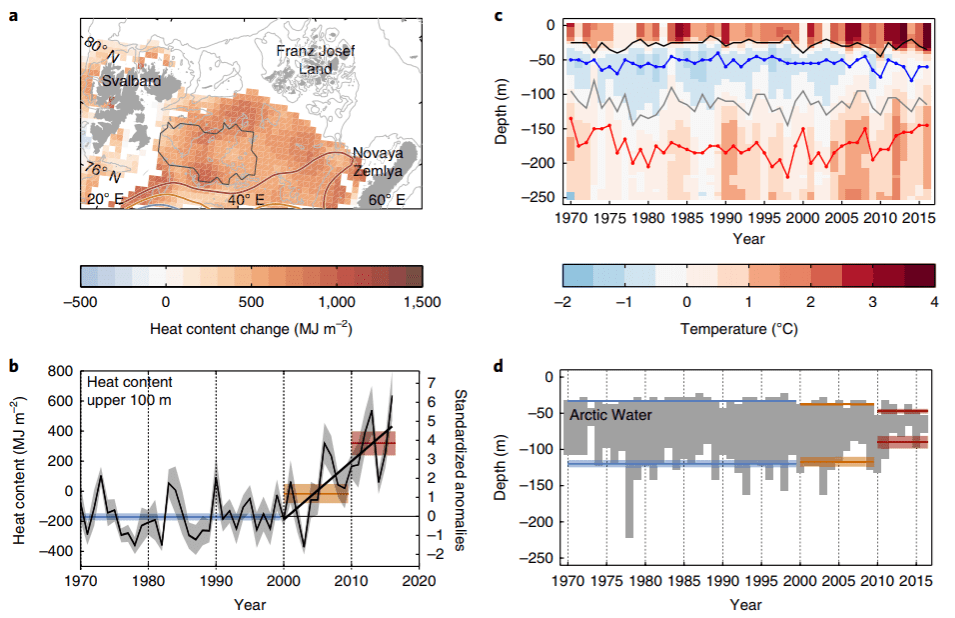We may have just witnessed a climate tipping point in the Barents Sea, research suggests.

Image credits NASA / Earth Observatory.
Climate change is a lumbersome beast. Threats associated with climate change — such as rising seas, an increase in extreme weather events, environmental degradation, or loss of biodiversity — involve huge and hugely complex systems, which have a lot of inertia. However, such processes are not completely devoid of sudden shifts, and we refer to these events as climate tipping points.
We’re pretty poor at spotting an incoming tipping point — but we’re quite capable of identifying them in retrospect; hindsight 20/20 and all that. While we’ve found evidence of such tipping points affecting Earth’s climate in the past, we couldn’t accurately reconstruct how fast these events took place. Now, a team of Norwegian researchers says they’ve watched such a tipping point while it was happening. According to a paper they recently published, this tipping point involves the Barents Sea. The loss of Arctic sea ice in the region has fundamentally changed the Sea, from a buffer between the Atlantic and Arctic ocean into a de facto extension of the Atlantic.
A sea change
The Barents Sea lies north of Norway and Russia, flanked by the Atlantic to its west and the Arctic Ocean to its North. It’s also one of the most intensely-monitored areas in the world. The paper draws on over five decades of temperature, ice cover, salinity, and other indicators recorded in the area. This wealth of data allowed the team to reliably fix a baseline from which to spot longterm changes. It also means that we’ve just happened to spot a major change as it was taking place.
Ice from the Arctic Ocean spreads over the Barents during winter. It helps thermally insulate the waters and blocks incoming sunlight — which helps keep Arctic waters colder during summer months. As this ice melts, it creates a layer of fresh water that doesn’t mix with the column of salt water under it (salty water is denser), floating on the surface like oil on water instead. In contrast, water flowing in from the Atlantic is both warmer and saltier than that of the Barents Sea.
Because of this, the sea (which lies between the two oceans) boasts a layer of intermediate water. Arctic water and ice keep surface waters chilly and fresh. Water from the Atlantic, being dense, flows to the bottom; it’s not warm enough to rise towards the surface. The Barents’ waters lie between these two ‘intruders’, forming the intermediate layer, with its own salinity levels and average temperatures.
This layered structure was “remarkably stable” from 1970 all the way through 2011, the team notes. However, signs of change could be seen even as these layers persisted — atmospheric temperatures over the Arctic have seen a steady rise, warming faster than any other region on Earth. This contributed to a dramatic decline in ice cover throughout the Arctic Ocean, reaching then-record lows in 2007 and 2008.
Because there wasn’t any ice to flow south, the Barents remained relatively ice-free during the Arctic summer. Average sea-ice drift into the Barents in 2010-2015 was 40% lower than the 1979-2009 mean, the team writes. Right now, it’s completely ice-free, despite the fact that the melt season historically lasts through to September. The team also checked precipitation levels on islands bordering the Barents Sea, such as Svalbard and Franz Josef Land, to confirm that the loss of fresh water came down to loss of ice, not a change in weather patterns.

Image credits Lind et al., 2018, Nature.
The sea’s surface layer rapidly declined in the absence of ice to insulate it. The top 100m of water has heated up dramatically over the past few years, according to the team. Mean temperatures between 2010 and 2016 were nearly four standard deviations higher than the 1970-1999 mean. In 2016, they were 6.3 standard deviations higher.
Sandwiched between two warmer bodies of water, the intermediate layer has also been heating up. The team reports that starting with the late 2000s, the entire water column has both warmed and gotten saltier. The intermediate has now all but vanished from the Barents Sea, the team notes, which is now dominated by water flowing in from the Atlantic. Even worse, warmer waters with higher salt content make it extremely difficult for sea ice to re-establish itself during winter.
“Increased Atlantic Water inflow has recently enlarged the area where sea ice cannot form, causing reductions in the sea-ice extent,” the team writes.
“The entire region could soon have a warm and well-mixed water-column structure and be part of the Atlantic domain.”
While it may not sound like a big deal to us, from an ecosystems point of view, these changes are immense. The authors describe the Barents as “divided into two regions with distinct climate regimes—the north having a cold and harsh Arctic climate and ice-associated ecosystem, while the south has a favorable Atlantic climate with a rich ecosystem and lucrative fisheries”. Now, however, it’s becoming one big Atlantic climate ecosystem.
The findings help provide some context as to the sheer scale of changes such tipping points can usher in — and how fast they can do so. The team says we’re likely to see a lot of regional tipping points such as this one, not a single, planet-spanning super tipping point. The future, however, will be built on the sum of these events and the way they interact — making it extremely hard to predict just what that future will look like.
The paper “Arctic warming hotspot in the northern Barents Sea linked to declining sea-ice import” has been published in the journal Nature.






